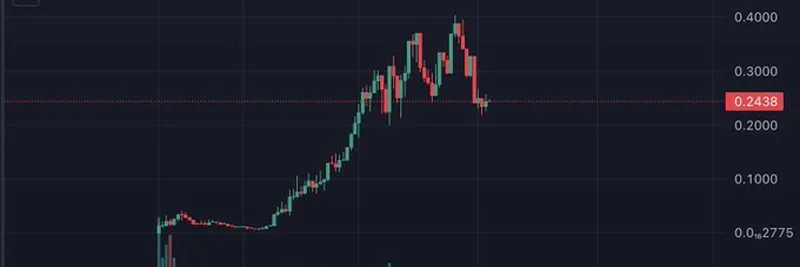Hey there, crypto enthusiasts! If you’ve been keeping an eye on the wild world of meme coins, you’ve probably heard whispers about the USELESS token on the Solana blockchain. Recently, a thread from StarPlatinumSOL dropped a bombshell, exposing some shady goings-on that every blockchain practitioner should know about. Let’s break it down and figure out what happened, why it matters, and how you can protect yourself in the meme coin jungle.
The Rise and Fall of USELESS Token
The story kicks off with the USELESS token, launched on May 10, 2025, via Raydium’s LaunchLab—a platform designed to help new tokens get off the ground. At first, things looked promising. The price jumped from $0.005 to a staggering $0.41 by June 5—a 4,700% surge! It even hit an all-time high (ATH) on July 28. But here’s where the plot thickens: that peak was the signal for a massive exit.
On August 3, 48 wallets dumped their holdings, raking in over $722,000 in minutes. Some big players, like wallet 6Nc6emA2yHrgv9vipWrFu5W1zYq5ukhA6xYza6yS68u3 (selling $62,700 across nine transactions), and HcbCNLVcYA5LsAeX3uJDTZx9cAakcCuW9JwWUagQQENo (dumping $275,638 on August 1), were caught red-handed. This wasn’t just a sell-off—it looked like a coordinated dump.
Insider Trading Red Flags
What makes this even juicier is the hint of insider trading. The thread reveals that three wallets held nearly 28 million tokens each before the pump even started. These early accumulations suggest some folks had inside info about the token’s potential rise. Insider trading in crypto happens when someone uses non-public info to make trades, giving them an unfair edge. In traditional finance, this is illegal, but in the wild west of crypto, it’s trickier to police—especially on decentralized networks like Solana.
The sudden price spike and high trading volume before the ATH are classic signs of insider activity. If you’re new to this, think of it like a stock trader buying shares based on a secret merger announcement—except here, it’s all happening on the blockchain, where every move is traceable (if you know where to look).
From USELESS to Bonk Fun: The Rotation
These savvy (or shady) traders didn’t just cash out and disappear. After dumping USELESS, they rotated their profits into other tokens like IMAGINE, TOKABU, and TROLL, many of which launched on Bonk Fun—a platform that’s become a hotspot for meme coin creation since its April 2025 debut. Bonk Fun hosts 22,000 tokens daily, but only 0.86% survive past day one, making it a high-risk, high-reward playground. On July 7 alone, 13 wallets launched 4,281 tokens—talk about a token factory!
This rotation suggests a pattern: use one token to pump profits, then jump to the next hype train. It’s a strategy that keeps the money flowing for those in the know.
The Dev’s Dirty Laundry
The plot deepens with the developer behind USELESS, who’s been linked to other questionable projects like “Very Useful,” “Shitless,” and “Value Less.” Each time, the dev allegedly vanished after a “takeover” (or what some call a rug pull), leaving investors high and dry. A rug pull is when creators hype up a token, attract investment, then abandon the project and run off with the funds. The thread points to three takeovers (May 11, June 8, and August 2), each followed by a crash.
This dev’s track record raises red flags. If you’re investing in meme coins, always dig into the team behind the token. A history of disappearing acts is a loud warning siren!
Lessons for Crypto Investors
So, what can we learn from the USELESS token saga? First, meme coins can be a rollercoaster—fun when they’re up, brutal when they crash. Second, insider trading and rug pulls are real risks in this space. The thread calls USELESS a “funnel”—a system of wallet coordination, centralized supply, fake hype, wash trading (where traders artificially inflate volume), and Bonk Fun’s infrastructure.
Here’s how to stay safe:
- Do Your Research (DYOR): Check token ownership and trading patterns using tools like Dexscreener or on-chain analytics.
- Watch for Red Flags: Sudden pumps, heavy pre-launch holdings, or devs with sketchy pasts are warning signs.
- Diversify: Don’t put all your SOL into one meme coin basket—spread your risk.
- Stay Updated: Follow threads like this one on X to catch the latest scams in real-time.
What’s Next for Meme Coins?
The USELESS scandal shows that the meme coin market is still a bit of a wild west. Platforms like Bonk Fun and Raydium LaunchLab make it easy to launch tokens, but that accessibility also opens the door to scams. As the crypto community grows, so does the need for better regulation and education. For now, keep your eyes peeled and your wallet secure.
What do you think about this story? Have you encountered similar red flags in other tokens? Drop your thoughts in the comments—we’d love to hear from you! And if you want more deep dives into meme coins, check out our Meme Insider knowledge base for the latest insights.



